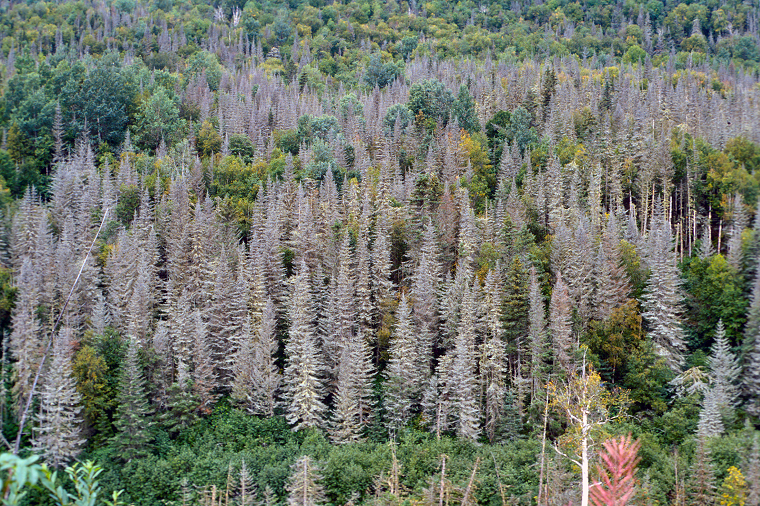Tiny Wasps Have Big Impact on Spruce Budworm Outbreaks
By Emily Trendos
22 September 2021

Trees killed by the spruce budworm during a cyclical outbreak (photo by the USDA Forest Service)
Every 35 years or so, a small non-descript forest pest known as the spruce budworm explodes in numbers. Outbreaks can last for several years and inflict immense damage to tens of millions of hectares of balsam fir and spruce trees. But along with these voracious caterpillars and the trees they devour, there is a third entity that also plays a major role in the outbreak: parasitoid wasps.
“When spruce budworm increases in population density, parasitoids will start attacking,” says PhD candidate Christopher Greyson-Gaito, Department of Integrative Biology. “They react super fast.”
Working with his advisors Drs. Kevin McCann, Department of Integrative Biology, and Eldon Eveleigh, the Canadian Forest Service, as well as a collaborator from the University of Freiburg, Greyson-Gaito studied multiple years of insect data from Atlantic Canada to understand how the parasitoid community responds to an outbreak.
Parasitoid wasps lay their eggs on or in caterpillars, where their larvae develop and eventually kill their host. Different species of wasps may prefer different hosts, but the community as a whole has one thing in common – they take rapid advantage of the spruce budworm during population outbreaks.
It’s a phenomenon that’s been coined “the birdfeeder effect”. As the number of budworm caterpillars increases, so too does the diversity of parasitoid species attacking them.
The spruce budworm presents a bountiful resource and the wasps respond accordingly. During a peak outbreak year, 99% of all spruce budworm-associated parasitoids were observed using spruce budworm as a host. But as the budworm population began to fall, the story shifted: three years later, only 53% of the wasps were parasitizing budworms, and after 10 years it was down to zero.
“We have this highly fluctuating large population of spruce budworm and then there’s a whole community of parasitoids surrounding that,” Greyson-Gaito says. “They interact and the spruce budworm obviously impacts the parasitoid communities, but those populations also impact the spruce budworm. There’s an interesting feedback with both of them.”
But what sustains the wasps between budworm outbreaks? Greyson-Gaito says this paper is the first step in answering that question.
The 35-year long spruce budworm outbreak pattern is thought to be a predator-prey cycle, with the collective parasitoid wasp community acting as the predator. Framing the relationship this way offers important insights into community ecology and food web dynamics, and shows that the parasitoids adapt to changing resource availability with a flexibility not all organisms exhibit.
Greyson-Gaito and his colleagues believe that hardwood trees, such as maples and birches, are key to maintaining the parasitoid community in between budworm outbreak years. These trees provide alternative caterpillar hosts when the budworm is not available in high quantities.
“You have two different energy channels that are oscillating at different times,” explains Greyson-Gaito. “When there’s tons of energy (prey) in one of them, the predator will take out energy from that system and it starts to go back down again. But in the meantime, the energy in the other channel will go back up. This leads to a huge energy flux there and then the predators will take energy out of that system. Altogether, the whole system is quite stable.”
In short, the parasitoid community as a whole likely works to keep high populations of spruce budworm in check during outbreaks. The wasps are able to quickly shift from using other host caterpillars, causing 30-90% mortality in the spruce budworm. Even wasps that rarely use the spruce budworm as a host were found to make this shift.
In addition to generating important ecological insights, these findings also have significance to forest management and the forestry industry. For example, in forests dominated by balsam fir, the budworm can move easily from one tree to the next. This means that increasing tree diversity in forests could mitigate budworm spread while increasing parasitoid wasp diversity and budworm predation.
“The goal isn’t necessarily to get rid of the outbreaks,” Greyson-Gaito says. “It’s to lessen how severe those outbreaks are.”
Further research is in the works to figure out how interspersing hardwood can best dampen spruce budworm outbreaks and enhance the natural relationship this species has with the parasitoid wasp community. The researchers are also interested in uncovering the relationships the wasp community has with other species of caterpillars.
“Some parasitoids will attack mostly spruce budworm. Some will attack spruce budworm and other caterpillars. Some will mostly attack other caterpillars. There’s a huge variety within this whole community,” says Greyson-Gaito. “It’s just cool.”
This study was funded by the Canadian Forest Service and the Natural Sciences and Engineering Research Council.
Read the full study in the journal The Canadian Entomologist.
Read about other CBS Research Highlights.